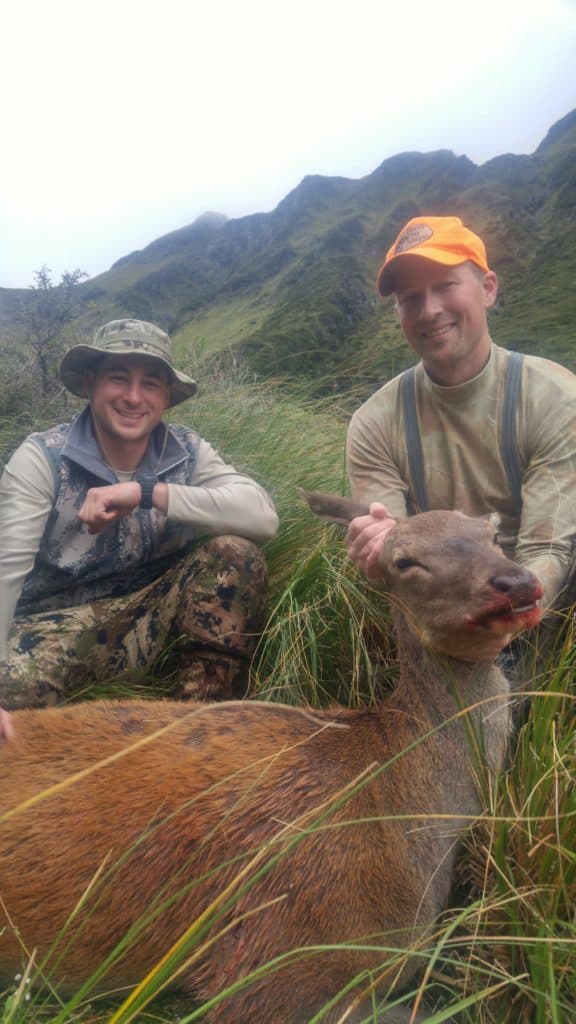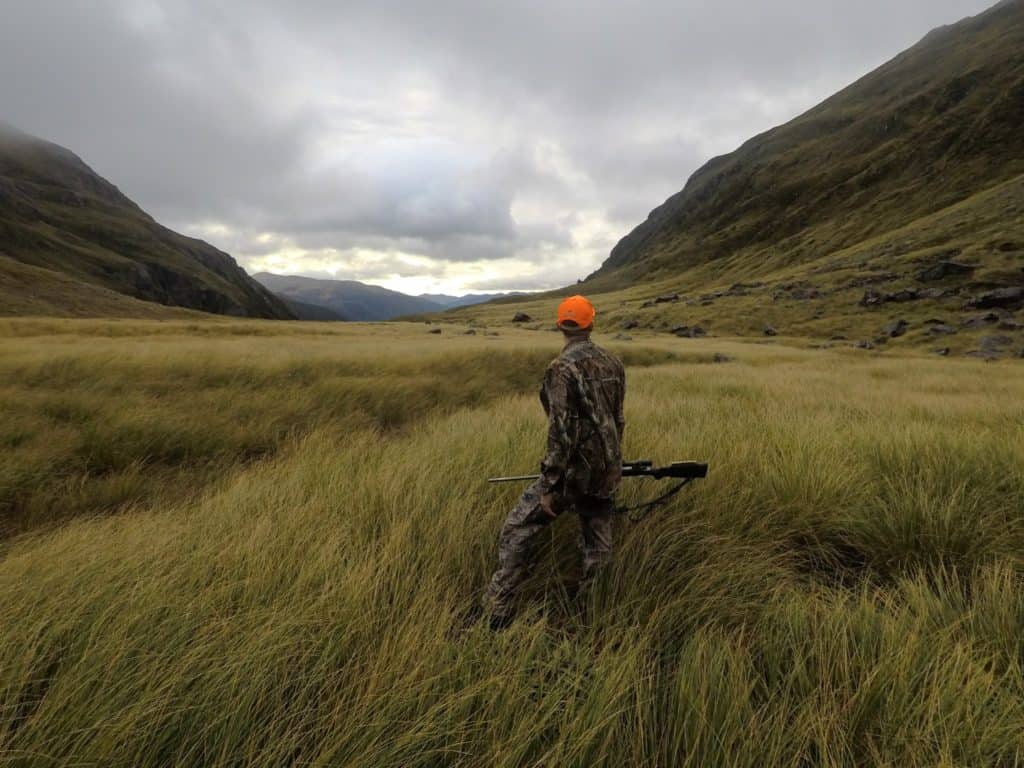Original Article: BREAKING BARRIERS, Union Sportsmen’s Journal, Fall/Winter 2022
by Kurt Beckstrom
Pipefitter Proves Hunting New Zealand isn’t a Pipe Dream
A decade of dreaming, a year of preparation, and 30-plus travel hours put this USA member exactly where he wanted to be.
Perched on a steep ridge some 8,000 miles from his home in Missouri, journeyman pipefitter and USA Conservation Programs Manager Sam Phipps and his companions glassed the opposite slope and the thick brush that choked the valley below for any hint of a giant red stag.
It was day three of the five-day New Zealand hunt for which Phipps, his brother pipefitter Mike Henderson, and his childhood friend Matt Jorens, had planned and prepped for nearly a year. A torrential downpour had trapped the hunters in their one-man tents for the best part of their first day, but once the weather broke, they spent every daylight hour hiking the exhausting terrain and scoping the landscape.
Expending some hard work and boot leather paid off, though, and the hunters finally got a glimpse of the red deer they came for. Henderson was first-up for the shot.
A SELF GUIDED INTERNATIONAL HUNT
– FAR FROM THEIR COMFORT ZONE
Though the friends had talked about and planned for their adventure for many months, Phipps’ desire to hunt red deer in New Zealand had been smoldering much longer.
“I watched a lot of hunting shows when I was a kid and remember seeing guys shooting those huge stags with massive antlers,” said the member of Plumbers and Pipefitters Local 562 headquartered near St. Louis, “and knew right off that it was something I wanted to do one day.”
Brought from Europe for the first time in the mid 1800s, red deer found a suitable home in New Zealand. More akin to the American elk than to mule deer or whitetails, red deer thrived, and the South Island has produced impressive trophies for hunters from all over the world.
But collecting a bone-studded head wasn’t the only thing that appealed to the young hunter. “There’s always been something about taking on the unknown that’s intrigued me,” he said. “I think everyone should step outside of their comfort zone and test themselves once in awhile. If you don’t, you’ll never find out what your capable of.”
Hunting from a do-it-yourself drop camp for a game animal they had never seen in the wild in a country they knew of mainly from the Internet, the three hunters were not just outside their comfort zone—they were barely within sight of it.
Full-service guided hunts on private property can run thousands of dollars per hunter, but New Zealand also offers vast areas open to public hunting. The mountainous terrain where red deer live, however, can challenge DIY hunters, especially first-timers unfamiliar with the species and terrain.
“Still, we were intent on a self-guided hunt,” said Phipps, “and not just for the cost savings.” Instead, they wanted to find animals and figure out their patterns and movements on their own. But with just five hunting days, they had to do it quickly.
To maximize their hunting opportunity, the friends chartered a helicopter to take them into and out of the mountains in the east-central region of New Zealand’s South Island. “The charter cost us about $500 each and was probably the biggest single expense of the trip,” said Phipps, “but the terrain in that part of the country is all up-and-down; the half-hour flight each way saved us a day’s hike in and a day’s hike out—time that we wanted to use scouting and hunting.”
SELF-MADE SUCCESS
Sleeping in single-man tents, fueling up on dehydrated meals prepared over Jetboil camp stoves, and burning countless calories trekking along mountain ridges was just the do-it-yourself experience the hunters wanted. But they got so much more.
“We were on an incredible hunting adventure in a place surrounded by beautiful mountains with these rugged valleys and tremendous waterfalls everywhere,” said Phipps. “It was a fantastic experience in an amazing part of the world.”
And things were about to get even better.
As the hunters glassed a new valley from above on the third day, they began to pick up movement in the thick brush below.
“We’d finally found an area that held animals,” Phipps said, “but the monkey scrub in the valleys is so dense, it’s tough to see anything, even with binoculars or a spotting scope. Then, you’d have to wait for the animal to move into a spot that offered a clear shot.”
Things came together when, at a range of 100 yards, a beautiful red hind (“cow” in elk hunting terminology) appeared through an opening in the scrub and dropped to Mike Henderson’s shot. The team scored its first success.
“That was on March 17,” recalled Phipps, “my birthday. And I could think of no better way to celebrate it than by packing the quarters back to camp—even though it was uphill all the way.”
After spending some time scouting another area without success the following morning, the hunters decided to revisit the spot where Henderson had connected. It wasn’t long before they started seeing animals, and Phipps collected his red hind with a 340-yard shot from his .300 Win Mag.
“Through all the immediate excitement, back-slaps, and hand-shakes, I thought about how I’d just done something that I’d dreamed of doing for such a long time.”
Matt Jorens came close the next and final day of the hunt, but he couldn’t make a clean shot, and the team wrapped up their great adventure going two-for-three.
THEIR ADVICE FOR A SUCCESSFUL INTERNATIONAL HUNT?
– CHASE THE DREAM
Phipps’ New Zealand dream began to form when he was a young whitetail hunter; it finally crystallized when he was a grown man with a wife, two sons, and a full-time job. During the years between—through his time as a U.S. Army Infantryman in Afghanistan, an apprentice in the Veterans in Piping program, and a union pipefitter beginning his career, the dream incubated and survived.
“Looking back, I think the biggest challenge in doing something like this, or attempting anything that’s way beyond the norm, is just getting up the nerve to do it,” Phipps said. “We’d talked about it enough times and knew we’d be heading into unfamiliar territory—but we had to go for it.”
There are other barriers to any great venture, of course, and the monetary cost involved is always a major consideration.
Phipps, Henderson, and Jorens saw the expense of round-trip airfare as the most daunting obstacle to hurdle. Until, that is, Henderson proposed they start banking frequent flyer miles.
“It was the perfect solution,” said Phipps. “We took a look at airlines and decided that American offered the most convenient flights; then we each applied for a credit card.”
Using his card for every single purchase he made and paying off the balance each month, Phipps earned enough miles for a free round-trip flight in just a year. That, combined with the modest cost of a self-guided hunt, and the fact that New Zealand requires no license fee to hunt non-native deer and other species, the trip was well within financial reach.
The friends are planning a return trip to New Zealand in 2021 to hunt tahr—a mountain goat species native to the Himalayas in Nepal. This time, however, the landscape won’t be so unfamiliar.







